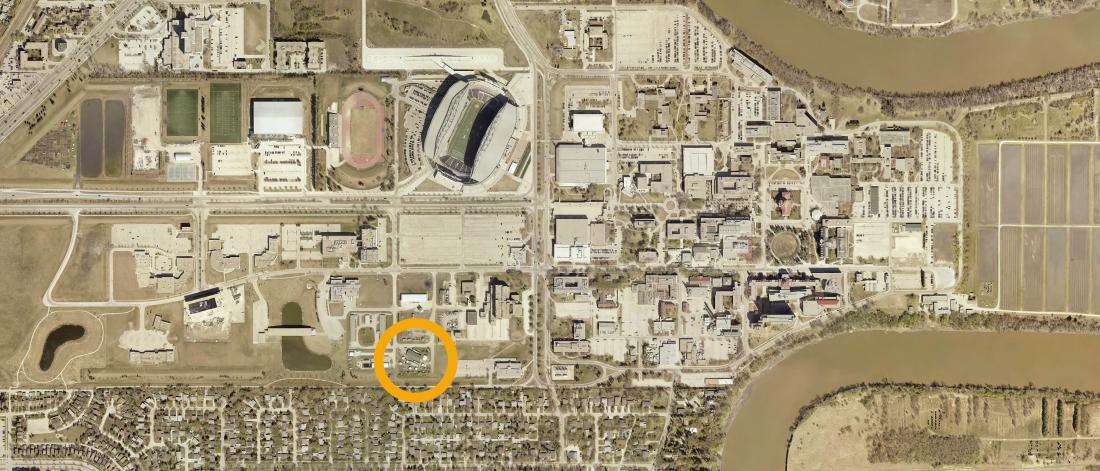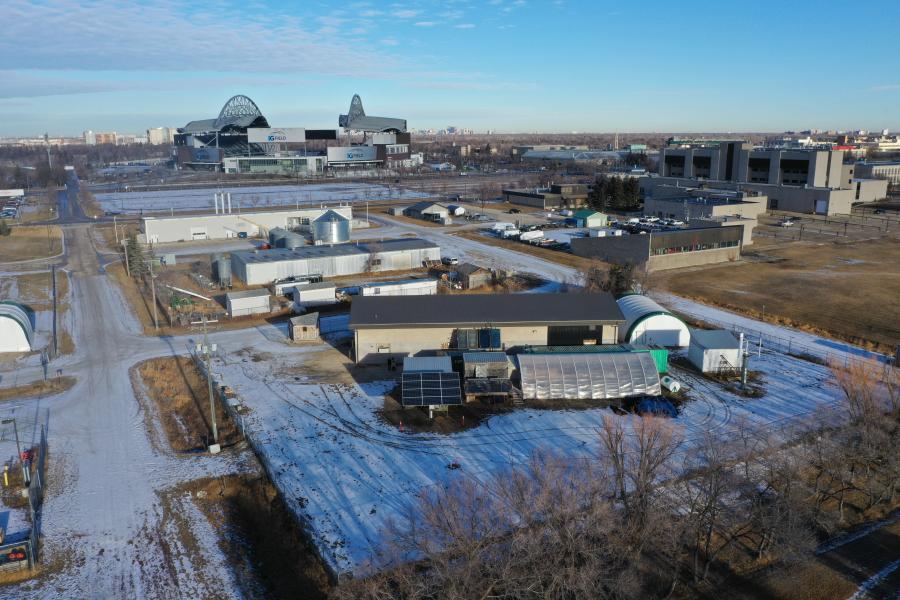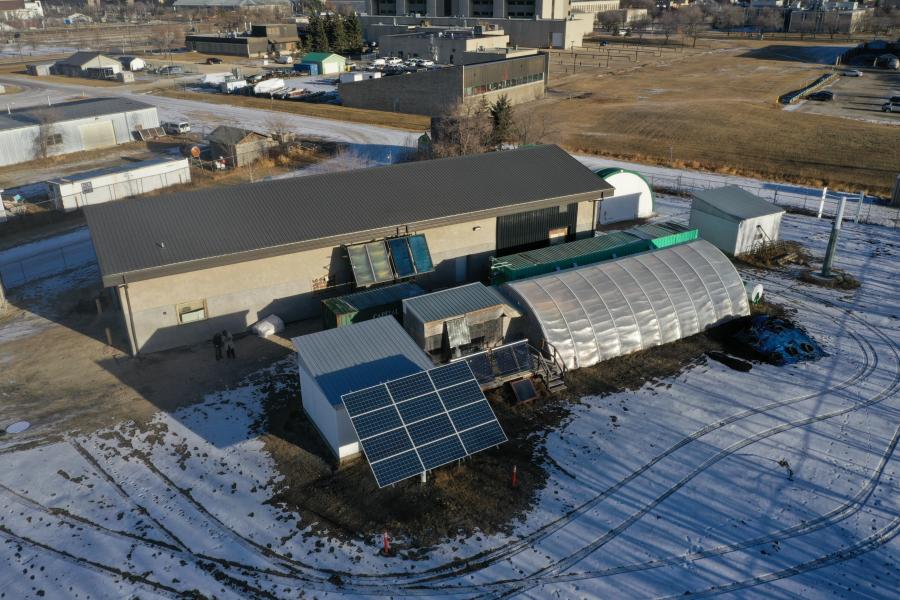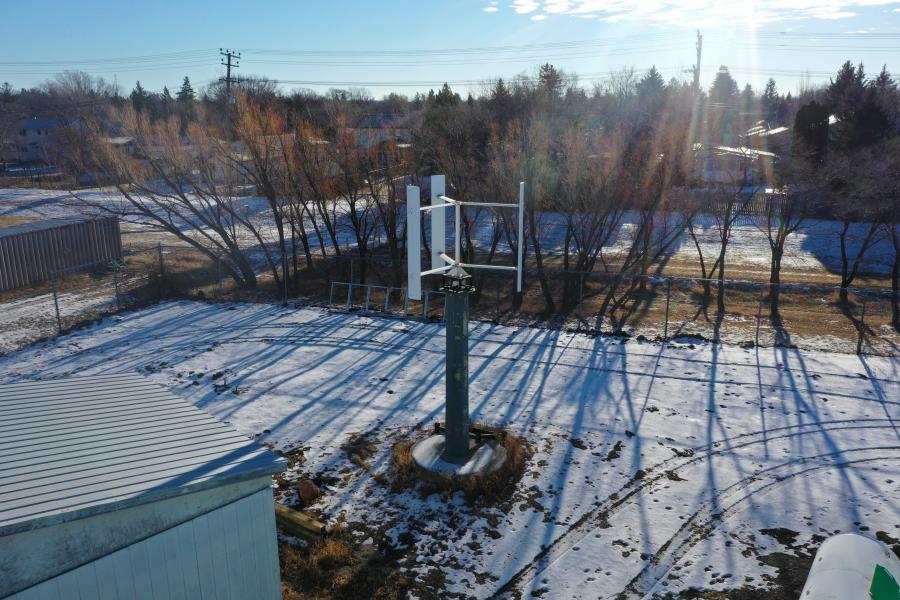SiAF Student Design Competition
The Department of Biosystems Engineering, with formal ties to both the Faculty of Agricultural & Food Sciences and the Price Faculty of Engineering, is committed to the establishment of a Sustainability-in-Action Facility (SiAF) that will be available to the University of Manitoba community for experiential learning and demonstration opportunities in areas of sustainability.
The design competition is initiated by the Department of Biosystems Engineering and organized in collaboration with the Department of Landscape Architecture and the Partners Program in the Faculty of Architecture.

Competition task
The task is a site design for the external environment bounded by the chain-link fence at the SiAF site. There is no specific design program for the site. The open areas can be used to demonstrate environmental sustainability (through vegetation and/or other materials) and social sustainability (i.e., Indigenous culture) while allowing flexibility for future ideas and projects. Existing renewable energy technologies (i.e., wind turbine, photovoltaic panels, etc) must remain accessible by foot and should be featured as “places of interest” within the site. Essentially, the Department of Biosystems Engineering covets an outdoor classroom (attractive gathering place), or learning environment, dedicated completely to sustainability.
The terrain is left marvellously open for the designers’ imagination with only a few requirements:
- it should be transformed into a welcoming and appealing place which allows individuals to explore the site and to learn about sustainability technologies featured at the site (including the renewable energy technologies already in place).
- ideally the SiAF site will incorporate electric vehicle charging infrastructure (most likely on the west end of the Strawbale building) to show the linkage between the generation and usage of renewable energy.
- recycling and/or upcycling of waste materials should be featured prominently to provide tangible evidence of the value of reusing waste materials.
Note: It is intended that the Wet Brayton Engine (#13) on the north side of the Strawbale building will be removed from the site in the summer of 2021.
Competition details
SiAF Site
The site is located on the west side of the Fort Garry campus at the site formerly referred to as the Alternative Village. The site is bounded by access roads on the east, north (Service 2 St SW) and west sides and a row of trees on the south side. In addition, the site is enclosed by a chain-link fence.
The centrepiece of the SiAF site is a large building that was constructed of straw bales. It is envisioned that the straw bale building can be transformed into a multi-use space that will be used for fabrication of student projects and hands-on lab activities. Adjacent to the strawbale building are several small structures that will have various purposes related to renewable energy, northern food production systems, and utilization of waste biomass. There are numerous renewable energy demonstration technologies scattered around the site. There is a large amount of open space on the south, east and west sides of the site.
SiAF Goals and implementation
The Department of Biosystems Engineering has established the following goals for the use of the SiAF facilities:
- To enhance sustainability content in undergraduate and graduate courses, both in Biosystems Engineering and across the entire campus, through access to experiential learning activities in the areas of renewable energy (solar, biomass, wind), innovative food production systems within controlled environments, sustainable building practices, and utilization of waste biomass fibre. This goal would be partially achieved by providing space and facilities for undergraduate design projects, undergraduate thesis projects, and extracurricular design teams working on relevant projects.
- To enable the University of Manitoba to engage in public education and outreach in the areas of sustainability, renewable energy, northern/urban food production, and utilization of waste biomass fibre through open houses, workshops, and media events.
- To initiate short-term demonstration projects with industry to showcase emerging sustainability technologies.
- To support innovative research activities in the areas of sustainability, renewable energy, northern/urban food production, and utilization of waste biomass fibre.
Besides technologies that contribute to sustainability, the Department of Biosystems Engineering would like the SiAF site to also reflect issues of social sustainability. Socially sustainable communities are equitable, diverse, connected and democratic, and provide a good quality of life (Western Australia Council of Social Services). Social sustainability combines design of the physical realm with design of the social world through the following assets: infrastructure that supports social and cultural life, social amenities, systems for citizen engagement, and space for people and places to evolve (Social Life).
According to the University of Manitoba’s commitment to Indigenous engagement and a university-wide strategy that promotes reconciliation, the Department of Biosystems Engineering would like the SiAF site to reflect Indigenous cultures in some manner.
The Department of Biosystems Engineering is interested to change the site’s current appeal as soon as possible. The project is to be implemented in a series of practical steps and the building process could be characterized by the application of construction techniques and materials which allow volunteers including students and teachers, of any skill and commitment level to get involved in building, while learning and laughing together. This participatory method opens up new perspectives for the future of the facility. It builds community and inspires focused participation.
Eligibility and prizes
The SiAF design competition is open to any student enrolled in the Faculty of Architecture at the University of Manitoba (in the 2020-2021 academic year). Interdisciplinary collaborations are encouraged. Team entries are welcome. Only one design per team or person is allowed.
The University of Manitoba Office of Sustainability ($3,000) the Faculty of Architecture ($2,000) and the Price Faculty of Engineering ($2,000) have offered to provide $7,000 in total for the competition in some instances in the form of tuition reimbursement.
The jury, acting unanimously, decide on the allocation of the prize groups and honourable mentions.
Schedule
Announcement: March 26, 2021
Q & A colloquium, via zoom: May 3, 2021 1:00pm | Zoom link
Tours of SiAF site (in small groups if health orders allow): May 4, 2021
Due submission, via upload: June 14, 2021
Adjudication: June 23, 2021
Announcement of winners: June 23, 2021
Submission information
Deliverables
- site plan, scale 1:200, north headed presentation
- sections and /or sectional elevations scale 1:200
- key details to appropriate scale
- perspective(s) and/or axonometry of the proposed space
- sketches and/or diagrams to illustrate and clarify the main idea
- title, central idea
- text, 700 words maximum, integrated into board layout
Submission format
- 2 design boards (pdf file format), A1 size (h:84.1cm, w:59.4cm), portrait orientation, high res (printable size, 300dpi)
- 2 design boards (pdf file format), A1 size (h:84.1cm, w:59.4cm), portrait orientation, low res (screen view, 150dpi)
All submission boards must include a six digit code number on the top right. The code number must consist of six different numbers, font size 36 point. The sequence of numbers shall not contain:
- due date for the competition submission
- numerical series
- six identical numbers
- birthday of the author(s)
Submission details
Submissions must be sent to Brandy O’Reilly, Faculty of Architecture Partners Program via WeTransfer link or Dropbox.
Entrant agreement
Authors of the design competition submissions retain the artistic copyright of their ideas. All awarded entries receive prize money. The Department of Biosystems Engineering might use ideas or single details for their intention to realize the project and/or parts of the project in steps at a later date. Alterations may not be made without formal consent of authors.
All entrants should note that the Faculty of Architecture and Price Faculty of Engineering assumes the right to use any submitted material for any promotional endeavor that the Faculty of Architecture and Price Faculty of Engineering deems fit.
For further information please contact:
Professor Dietmar Straub, Department of Landscape Architecture, Faculty of Architecture Dietmar.Straub@umanitoba.ca
Assessment criteria
The designs will be evaluated based on the ability to creatively showcase design excellence and sustainability:
- design idea
- sustainability concerning construction and materiality
- innovative approach regarding the application of plants and materials
- overall spatial expression and form (gestalt)
- commitment to sustainability and (bio)diversity
- long term care and maintenance
Jury members
Danny D. Mann, Ph.D., P.Eng.
Professor & Head, Department of Biosystems Engineering, University of Manitoba
Nazim Cicek, Ph.D., P.Eng.
Professor & Acting Head, Department of Biosystems Engineering, University of Manitoba
Joe Ackerman, Ph.D.
SiAF Manager, Department of Biosystems Engineering, University of Manitoba
Kale Kostick
Acting Director, Office of Sustainability, University of Manitoba
Shawn Bailey
Assistant Professor, Faculty of Architecture, Department of Architecture
Price Faculty of Engineering, Indigenous Scholar, Architect, University of Manitoba
Suzy Melo, B. Env., MLArch
ft3 Architecture Landscape Interior Design, Landscape Architect, Winnipeg, Manitoba
Dietmar Straub
Professor, Department of Landscape Architecture, Landscape Architect and Urban Designer, University of Manitoba
All decisions will be made with a simple majority of the votes. The jury decision is final and not contestable.
Competition files
SiAF competition brief SiAF competition registration form
Existing site plan files (.dwg and .vwx) are available for download from the SiAF Competition Files folder.
Late or incomplete submissions will not be accepted.




